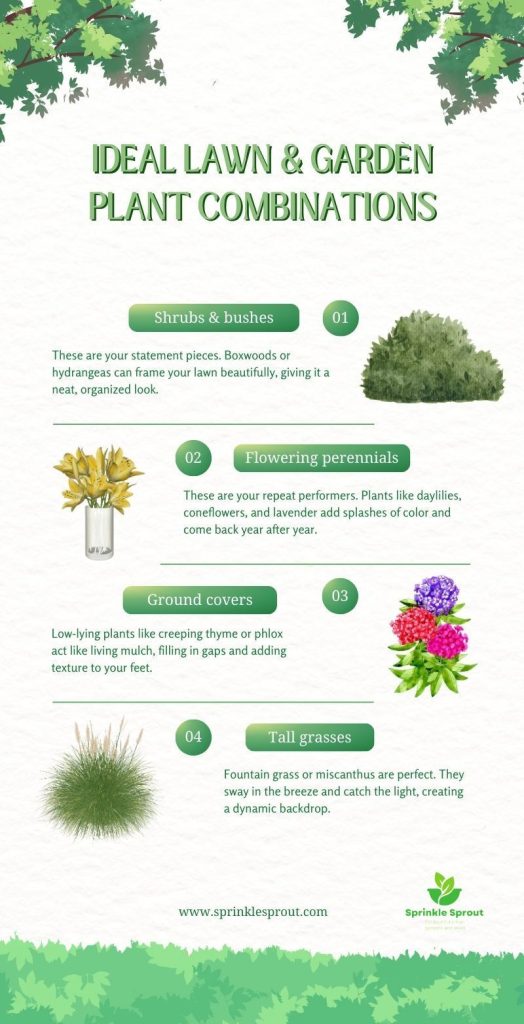Learn how to keep your lawn and home garden thriving with top maintenance tips, from combining plants to treating pests and diseases.
Source: https://pixabay.com/photos/grass-lawn-green-mown-mowed-220465/
Imagine your lawn as a lush, green carpet – soft, inviting, and perfect for bare feet. Now, add a splash of color with flowers like cheerful daisies, fragrant lavender, and bold sunflowers. It’s like tossing vibrant pillows onto that plush carpet, making it pop and come alive.
You don’t need to be a pro to pull this off. With a bit of time and creativity, you can turn your yard into your private paradise. A place where you can sip your morning coffee while the dew is still fresh on the grass or watch the sunset with the fragrance of your garden in the air.
Sounds tempting, doesn’t it? Let’s turn it into reality – we’ll teach you how.
Table of Contents
Ideal plant combinations for your lawn and home garden
Picking the right plants to complement your lawn is like choosing the perfect accessories for your favorite outfit. Some of the best buddies for your grass carpet are:
- Shrubs and bushes: Think of these as the statement pieces. Boxwoods or hydrangeas can frame your lawn beautifully, giving it a neat, organized look.
- Flowering perennials: These are your repeat performers. Plants like daylilies, coneflowers, and lavender add splashes of color and come back year after year.
- Ground covers: Low-lying plants like creeping thyme or phlox act like living mulch, filling in gaps and adding texture to your feet.
- Tall ornamental grasses: Fountain grass or miscanthus are perfect. They sway in the breeze and catch the light, creating a dynamic backdrop.
- Seasonal annuals: Pansies in spring, petunias in summer, or chrysanthemums in fall bring vibrant colors and beautiful fragrances.
Benefits of a lawn and home garden pairing
Pairing a lawn with a home garden brings many benefits besides making your yard look good. This combination can improve your environment, offer health benefits, and create a peaceful place for you to relax.
Let’s explore why having a lawn and garden together is an excellent idea for your home.
1. Environmental impact
Your lawn and garden are nice to look at, but they’re doing good for the environment, too. They:
- Clean the air by taking in carbon dioxide and giving out oxygen
- Keep the air clean by catching dust and other pollutants
- Prevent soil from washing away
- Clean rainwater as it soaks into the ground, improving the groundwater quality
- Cool down the area around your house on hot days
2. Wildlife habitat
By planting various flowers, shrubs, and trees, you’re creating a mini-habitat right in your backyard. This environment attracts birds, bees, and butterflies. You provide them with food, shelter, and a place to raise their young. Your garden can be a small wildlife sanctuary, contribute to biodiversity, and help maintain healthy ecosystems.
3. Relaxation and stress relief
Whether you’re gardening, playing with the kids, or just sitting back enjoying the view, being surrounded by nature can calm your mind and boost your mood.
Taking care of plants, watching them grow, and seeing the fruits of your efforts also brings a deep sense of satisfaction and peace. It’s a great way to escape from the hustle of daily life and find a moment of tranquility.

4. Hobby for all family members
Gardening is a fantastic hobby the whole family can get involved in. It’s fun and educational, especially for kids. They get to learn about plants, insects, and nature. It’s a hands-on experience where they can see the results of their care and effort as plants grow and bloom.
Gardening encourages creativity and teamwork, as the family plans and builds the home garden together. It’s a great way to spend quality time, learn new skills, and create lasting memories.
Challenges in maintaining lawn and garden
Caring for a lawn and garden can be incredibly rewarding, but it’s challenging. From pesky bugs to keeping up with the changing seasons, there are a few hurdles you must be aware:
1. Managing pests and diseases
Pests can cause various problems, from chewing on leaves and flowers to spreading plant diseases. If left unchecked, they can significantly weaken or even kill your plants.
Regularly check your greenery for pests or signs of disease to take action before the problem escalates. Chemical-free options like neem oil or insecticidal soaps can be effective against pests without harming beneficial insects or the surrounding environment.
Additionally, introducing natural predators into your garden, such as ladybugs to combat aphids, can provide a sustainable way to control pest populations. These predators naturally keep harmful insect populations in check, reducing the need for chemical interventions.
2. Watering requirements
Understanding what each type of plant in your garden requires will go a long way in maintaining a healthy outdoor space. Finding a balance between over- and under-watering can be tricky, and both can have severe consequences:
- Over-watering can lead to root rot, a condition where roots can’t get the air they need, and it also encourages the growth of mold and fungi.
- Under-watering stresses plants, leading to wilting, leaf drop, and, in severe cases, death.
To manage water use effectively, set up a drip irrigation system that brings water directly to the plant base, reducing waste and evaporation. Adjust your watering according to the season – plants generally need more water during hot, dry periods and less during cooler times.
Mulch the area around your plants to keep the soil moist and reduce the watering. Mulch also keeps the soil cooler and helps prevent weed growth.
3. Balancing sunlight and shade
An enormous challenge in having a lawn and a garden is ensuring everything gets the right amount of sun. A lawn usually loves lots of sunlight to stay lush and green. But your garden plants can be picky – some need full sun, while others do better in the shade. It gets tricky when trees or structures throw shade over parts of your lawn, which can lead to uneven grass growth. You’ve also got to watch out for taller plants that might block the sun from smaller ones or the grass.
The solution? Thoughtful plant selection and garden layout. Choose shade-tolerant varieties for less sunny areas, and ensure each part of your garden and lawn gets the right amount of light. With some planning, you can keep your entire outdoor space thriving.
Seasonal tips for lawn and garden care
Adapting your lawn and garden care to the changing seasons is crucial for keeping it healthy and beautiful. Each season brings unique conditions that require specific gardening practices:
Spring preparation
It’s time to prepare for new growth as the weather warms up. Spring is ideal for planting most flowers, vegetables, and other plants.
- March: Clean your garden beds, removing debris and dead plant residues. Plant hardy vegetables and flowers that can handle a bit of cold, like peas and pansies.
- April: Time to plant most of your seeds outdoors. Start regular lawn mowing as grass growth speeds up. Fertilize your lawn and garden beds to encourage growth.
- May: Increase watering as the weather warms up. Continue planting summer flowers and vegetables. Begin mulching to keep soil moisture and control weeds.
Summer maintenance
Summer is all about maintenance:
- June: Monitor for pests and diseases. Deadhead spent flowers to encourage new blooms. Water your garden more frequently as temperatures rise. Weed frequently to prevent weeds from competing with your plants for nutrients and water.
- July: Consistent watering is vital during hot summer months. Harvest vegetables as they ripen. Prune summer-flowering shrubs after they bloom.
- August: Start preparing for fall planting. Keep watering, especially during dry spells. Begin seeding fall crops like spinach and kale.
Fall readiness
As the growing season winds down, fall is the time to prepare your garden for the colder months ahead:
- September: Reduce watering as temperatures cool. Plant fall perennials and prepare your lawn for fall with aeration and overseeding if necessary. Begin gathering seeds for next year.
- October: Harvest remaining crops before the first frost. Clean up fallen leaves and add them to your compost. Plant bulbs for spring blooms.
- November: Protect sensitive plants from early frosts with mulch. Drain and store garden hoses and irrigation systems. Apply a last layer of mulch to protect plants over winter.
Winter protection
During the winter, the focus shifts to protection. Winter is mostly a dormant period for the lawn, so all the maintenance comes down to avoiding walking on frozen grass to prevent damage.
- December: A quiet month for gardening, but you can focus on tool maintenance. Plan for next year’s garden, considering changes based on this year’s experiences.
- January: Protect plants from frost using burlap or frost cloths. It’s an excellent time to plan your garden layout and plant choices for the upcoming seasons.
- February: Start seeding indoors for certain plants, like peppers or tomatoes, that require a longer growing time. Prune trees and shrubs, as they are still dormant.
Maintenance tips for a thriving lawn and garden
You don’t want your green area just to survive but to thrive, and for that, you’ll use these maintenance tips:
Regular weeding
- Remove weeds frequently to prevent them from suffocating your plants. They’ll take nutrients, water, and sunlight away from your plants if you let them.
- Use mulch to prevent weeds and keep the soil moist.
- Consider using a weeding tool or hoe for easier removal, especially for larger areas.
- Weed after rain or watering, as wet soil facilitates pulling out the entire root.
- Use natural herbicides like vinegar or boiling water for an eco-friendly weed control option.
Proper watering techniques
- Water thoroughly but less frequently to encourage strong and deep root growth.
- The best time to water is early morning or late evening to reduce evaporation.
- Use a soaking hose or drip irrigation system for targeted watering.
- Collect rainwater in barrels for an eco-friendly and cost-effective watering solution.
- Adjust watering based on rainfall and seasonal changes.
Soil health
- Test your soil to understand its nutrient content and pH level; adjust as needed.
- Add compost or other organic fertilizer annually to improve soil structure and fertility.
- Rotate crops in vegetable gardens to prevent nutrient depletion and disease buildup.
- Aerate your soil periodically to improve water and nutrient absorption.
- Avoid compacting soil by not walking on wet ground and using stepping stones in high-traffic areas.
Pruning and deadheading
- Prune shrubs and trees to remove dead or diseased branches and to shape them.
- Prune flowering shrubs and trees in the early spring to encourage healthy growth and flowering.
- Use clean and sharp tools for cutting to prevent disease transmission.
Lawn mowing and edging
- Mow your lawn to the ideal height for your grass type, usually between 2.5 to 3 inches.
- Keep mower blades sharp for clean cuts, which are healthier for the grass.
- Edge your lawn to create a clear boundary between it and garden beds or pathways.
- To prevent stressing the grass, trim one-third of the blade length at most.
- Change the mowing pattern each time to prevent grass from leaning and growing in one direction.
- Use grass clippings as a natural fertilizer by leaving them on the lawn.
Ready to enrich your lawn with some plants?
And there you have it—your guide to create and care for a beautiful lawn and garden combo. Remember, it’s all about regular care, understanding the needs of your plants, and adapting to the challenges that come your way. With a bit of effort and planning, you can enjoy a lush, healthy outdoor space that’s a joy to spend time in. So, grab your gardening tools and make your green space shine!
